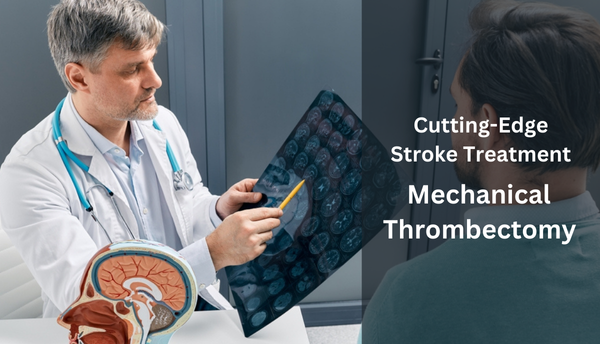Cutting-Edge Stroke Treatment: Mechanical Thrombectomy at Accord Hospital
Stroke is a leading cause of death and disability worldwide However, recent advances in medical technology, particularly mechanical thrombectomy, are transforming stroke care. This procedure offers significant hope for ischemic stroke patients, potentially reversing outcomes from severe disability or death to full recovery with timely treatment.
Understanding Ischemic Stroke and Mechanical Thrombectomy
An ischemic stroke occurs when a blood clot blocks an artery, cutting off the blood flow to a part of the brain, leading to brain damage. Traditional treatment involves clot-dissolving medicine (thrombolytics) administered within 4.5 hours of stroke onset, but these are not always effective. Mechanical thrombectomy offers a direct solution by inserting a catheter upto the clot’s location in the brain and physically removing the clot by devices like stentretriever that helps in quick restoration of blood flow to the area of ongoing damage. This procedure is often combined with thrombolytic medicines but can also be used as sole modality when thrombolytic medicines are contraindicated or ineffective.
Advancements and Future Prospects
Mechanical thrombectomy is the most efficacious intervention which improves stroke outcome, particularly for patients with major strokes.
Extended Time Window: Currently mechanical thrombectomy can be successfully done in many patient upto 24 hours of stoke onset. Ongoing research is paving the ways to extend the time window even further, allowing more stroke patients to get benefit from this life-saving procedure.
Improved Devices: The technology in developing thrombectomy devices is ever evolving, with new designs concentrating on better clot removal and shorter procedural time. These advancements make the treatment safer and more successful, especially in technically difficult situations.
Broader Application: Efforts are being made to extend the use of thrombectomy to a broader spectrum of patients, including those with stroke due to smaller vessel occlusions. This would increase the number of patient eligible for such life saving therapy.
Integration with Telemedicine: Another promising development is the incorporation of telemedicine/telestroke into stroke care. Telemedicine can help in speeding up decision-making and transfer of patients to thrombectomy centers particularly from areas with limited access to specialized treatment.
Artificial Intelligence and Machine Learning: Artificial intelligence and machine learning algorithms aid in quick diagnosis of stroke and selection of appropriate candidates for thrombectomy. These technologies have the potential to improve decision-making, treatment techniques, and overall patient outcomes.
As technology continues to advance, and as our understanding of stroke pathophysiology deepens, the future of stroke management looks increasingly bright. By continuing to innovate and invest in stroke care, we can ensure that more patients have the opportunity to reclaim their lives after a stroke, transforming the landscape of stroke care for generations to come.
Your Question Answered by our Expert;
Q1: What is brain stroke?
Brain stroke occurs when the blood supply to a part of the brain is cut off, depriving brain tissue of oxygen and nutrients, leading to cell death within minutes.
Q2: What are the types of brain strokes?
- Ischemic stroke: Caused by blockage in a blood vessel supplying a part of the brain.
- Hemorrhagic stroke: Caused by a rupture of blood vessel in any part of the brain.
Q3: What are the symptoms of a stroke?
Common symptoms include:
- Sudden weakness or numbness in the face, arm, or leg, especially on one side.
- Confusion, difficulty in speaking or in understanding speech.
- Sudden vision problems.
- Dizziness or loss of balance.
- Sudden loss of consciousness
Q4: What are the common risk factors for a stroke?
Risk factors include high blood pressure, diabetes mellitus, smoking, obesity, high cholesterol level, and family history of stroke.
Q5: How can a stroke be prevented?
Prevention involve managing risk factors through a healthy lifestyle, including a balanced diet, regular exercise, avoiding tobacco, and controlling high blood pressure and diabetes mellitus.
Q6: What should be done if someone is suspected of having a stroke?
Call emergency services immediately. Prompt action is crucial to minimize brain damage and improve the chances of recovery.
Q7: Why is it important to act quickly if a stroke is suspected?
Acting quickly can reduce brain damage and improve recovery. Time is critical: “Time is Brain. Time Lost is Brain Lost.”
Q8: What treatments are available for a stroke?
Treatment of stroke depends upon the type of stroke. It includes blood thinners (antiplatelets, anticoagulants), clot dissolving medicines and mechanical thrombectomy for ischemic stroke and surgical interventions in cases of hemorrhagic stroke. Urgent medical care is essential for improving recovery outcomes.



